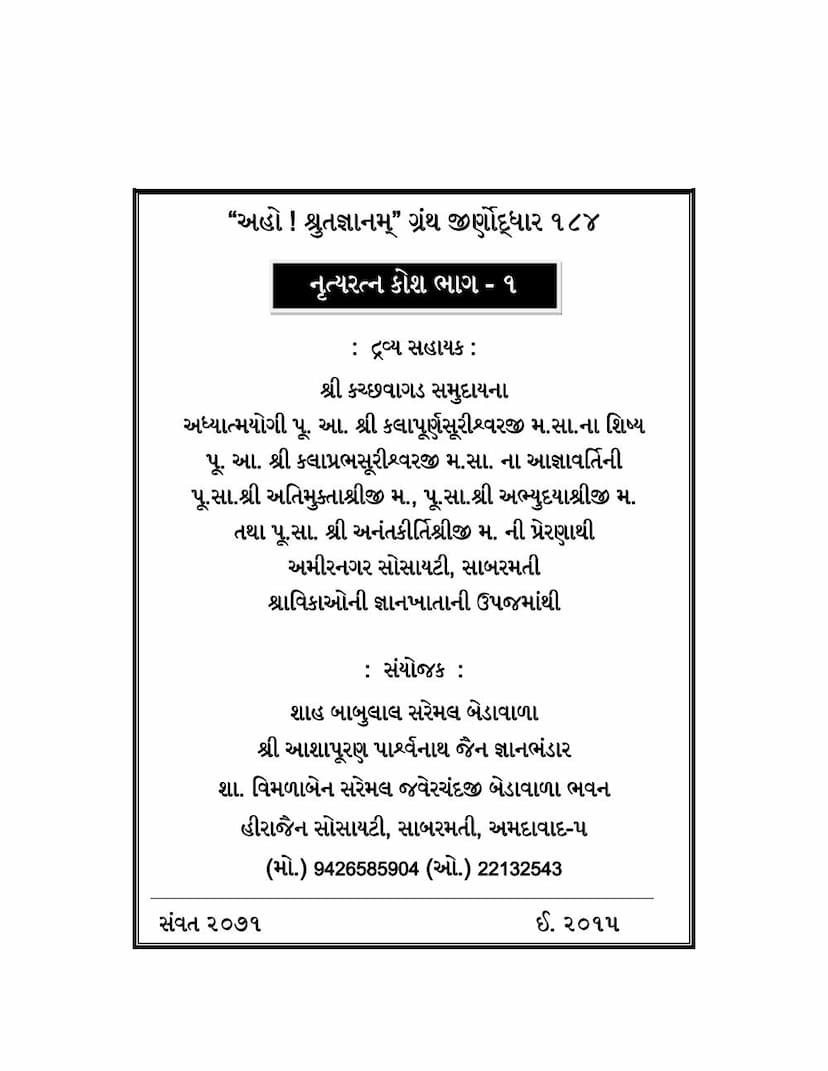Nrutyaratna Kosh Part 01
Added to library: September 2, 2025

Summary
The provided text is the first part of "Nrutyaratna Kosh" (नृत्य रत्न कोश), authored by Kumbhkarna Nrupati (कुम्भकर्ण नृपति). Published by Rajasthan Purattvanveshan Mandir (राजस्थान पुरातत्त्वान्वेषण मन्दिर), this work is part of a larger project by the Shri Ashapooran Parshwanath Jain Gyanbhandar (श्री आशापूरण पार्श्वनाथ जैन ज्ञानभंडार) to digitize and preserve rare Jain manuscripts.
The catalog link points to a digital collection of ancient and often rare books that have been scanned and made available on DVD and online through www.ahoshrut.org. "Nrutyaratna Kosh Part 01" is listed within this collection, specifically as part of Set No. 6 (संवत २०७१ / ई. 2015).
The text itself, as presented in the extensive page extracts, is a detailed and technical treatise on Indian classical dance (Nritta). It delves deeply into the various aspects of dance as understood in ancient Indian tradition, likely drawing from and elaborating on foundational texts like Bharata Muni's Natyashastra and other related works on music and performing arts.
Here's a breakdown of the key components and themes covered in the provided pages:
-
Introduction and Context: The initial pages highlight the preservation efforts, crediting individuals and institutions involved in the publication and digitization. They emphasize the importance of reviving and making accessible these valuable ancient texts. The text is presented as a significant literary work and a "historical monument" of Sanskrit literature, compiled by Maharana Kumbhakarna.
-
Structure of the Work: The extracts show the beginning of the first "Ullasa" (उल्लास - chapter or section) titled "Angaparikshana" (अङ्गपरीक्षणं - Examination of Limbs/Parts). This section is further divided into specific examinations:
- Pratham Parikshana (प्रथम परीक्षण): This covers the "Abhinaya" (अभिनय - expressive aspect of dance), detailing different types of abhinaya (Ahgika - bodily, Vachika - vocal, Aharya - external/costume, Sattvika - emotional/internal) and their nuances.
- Dwitiya Parikshana (द्वितीय परीक्षण): This focuses on "Charis" (चारी - movements of the feet and legs) and "Sthanakas" (स्थानक - postures or positions), categorizing them into "Marga" (मार्ग - classical/standard) and "Deshi" (देशी - regional/folkloric) styles. It lists and describes numerous distinct movements and stances.
- Tritiya Parikshana (तृतीय परीक्षण): This examines "Upangas" (उपाङ्ग - minor limbs or features of the body), including detailed descriptions of facial expressions (eyes - Drishti, eyebrows - Bhrū, eyelids - Puta), nose (Nasa), breath (Anila), lips (Adhara), teeth (Danta), tongue (Jihva), chin (Chibuka), and face (Vadana).
- Chaturtha Parikshana (चतुर्थ परीक्षण): This deals with "Aharya Abhinaya" (आहार्याभिनय - external presentation), covering costumes (Vastra), ornaments (Alankara), body coloring (Angaracana), and props or dummy figures (Pusta). It also touches upon "Mukharaga" (मुखराग - facial coloring) and "Hasta" (हस्त - hand gestures), including their classifications and specific applications.
-
Detailed Exploration of Dance Elements: The bulk of the text is dedicated to defining and explaining the terminology and techniques of classical Indian dance. This includes:
- Angas (अङ्ग) and Upangas (उपाङ्ग): Detailed descriptions of the movements and positions of the head (Shiro), shoulders (Skandha), neck (Griva), arms (Bahu), waist (Kati), thighs (Uru), legs (Jangha), knees (Janu), and feet (Pada), including their various states and expressive capabilities.
- Karanas (करण) and Angaharas (अङ्गहार): Mentioned as essential components of dance, with detailed explanations of various hand gestures (Hasta - Karyas/Karanas), their formations, and their applications in expressing different emotions and actions. The text enumerates a vast number of hand gestures (over 64, with specific classifications like united and separate hands) and their associated meanings.
- Charis (चारी): A comprehensive cataloging of different types of foot and leg movements, categorized into "Marga" (classical) and "Deshi" (regional/folk), and further into "Bhaumi" (earth-bound) and "Akashiki" (aerial). Each chara is described with precise terminology for foot placement, body posture, and movement.
- Sthanakas (स्थानक): Various static postures of the body, also classified as Marga (for males and females), Deshi, Upavishta (seated), and Supta (lying down) positions, with detailed descriptions and their emotional associations.
- Rechaka (रेचक): Movements of the limbs, particularly the hands, feet, waist, and neck, used for purification and grace within the dance.
- Mudras (मुद्रा): Hand gestures are extensively covered, with detailed descriptions of numerous categories like Pataaka, Tripataka, Ardha-chandra, Kartarimukha, etc., and their respective applications.
- Body Language: The text emphasizes the importance of facial expressions, eye movements, and subtle bodily shifts in conveying emotion and narrative.
-
Authoritative and Scholarly Approach: The author, Kumbhakarna, is presented as a learned ruler and scholar, and the text reflects a deep understanding of the performing arts, drawing from established traditions. The scholarly nature is evident in the detailed classifications, technical terminology, and references to earlier authorities.
In essence, "Nrutyaratna Kosh Part 01" is a foundational text for understanding the theoretical and practical aspects of classical Indian dance from an ancient Jain perspective, presented through the lens of a scholarly king. It's a vital resource for researchers, practitioners, and enthusiasts of Indian performing arts, particularly within the Jain tradition.